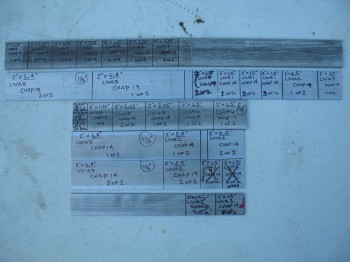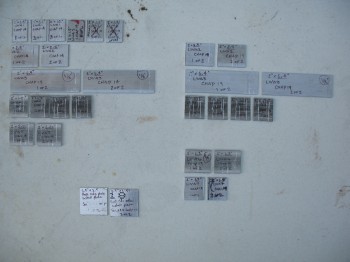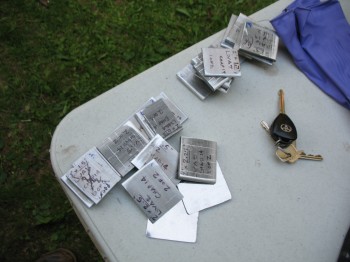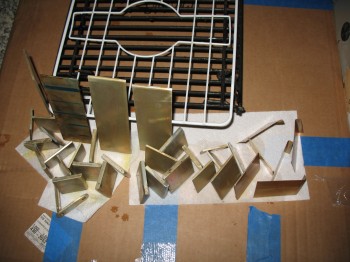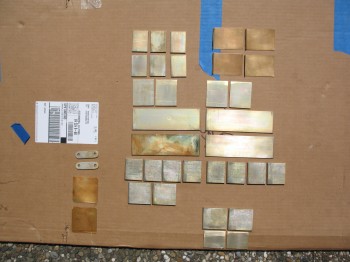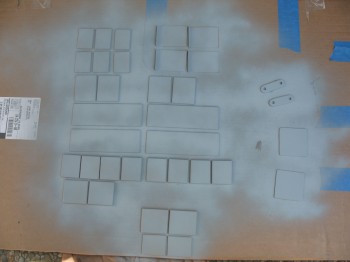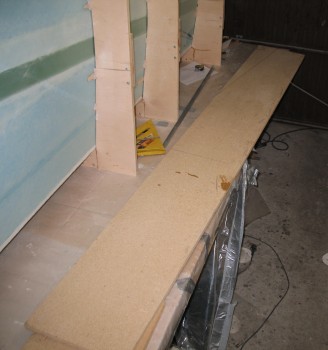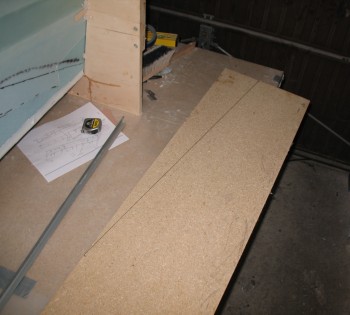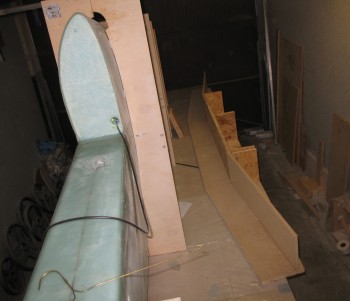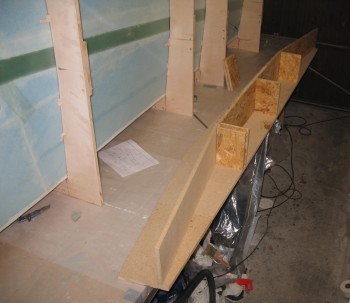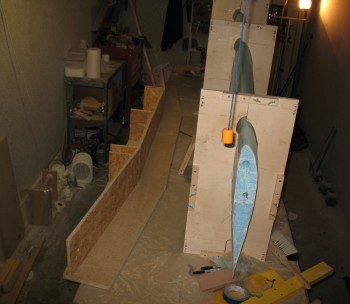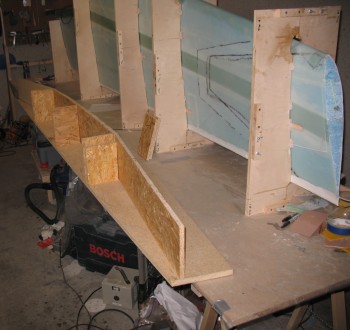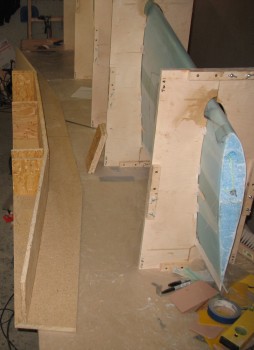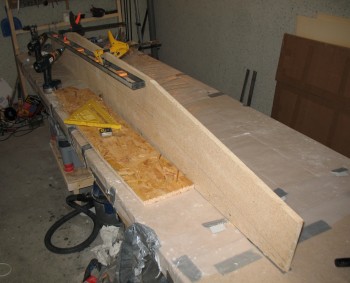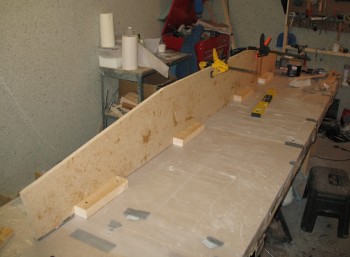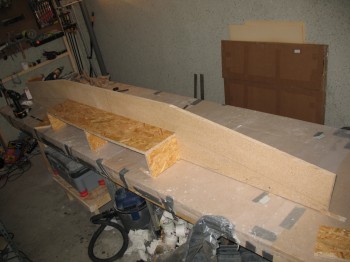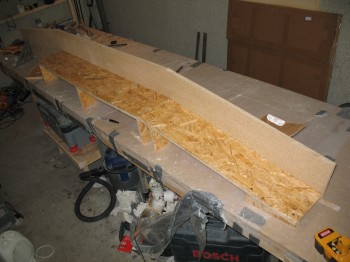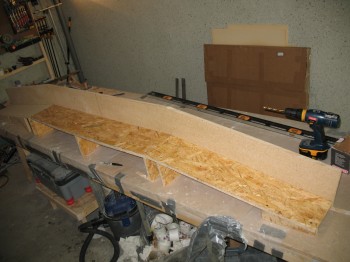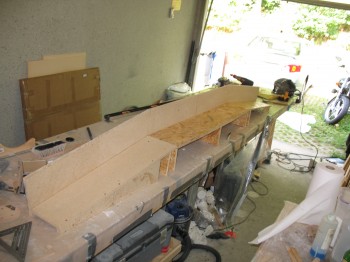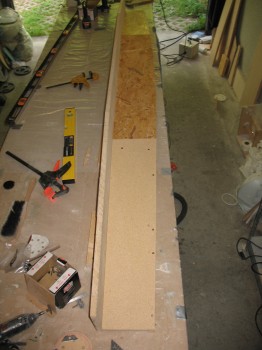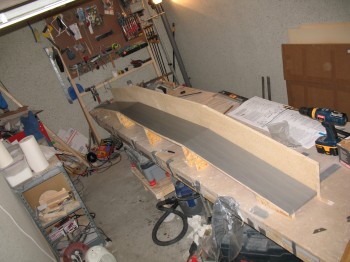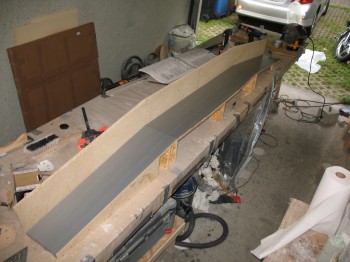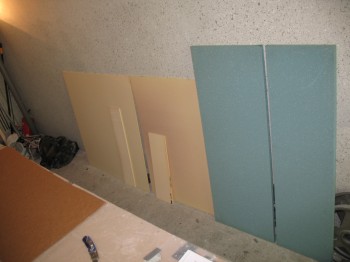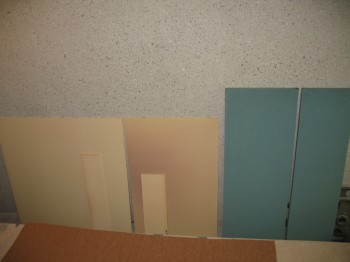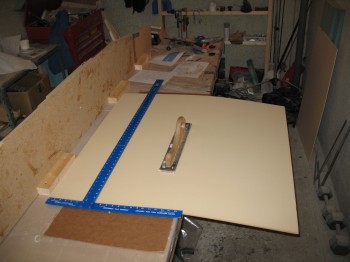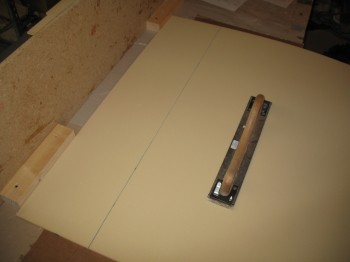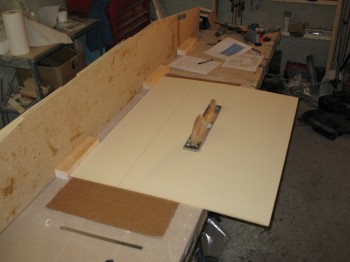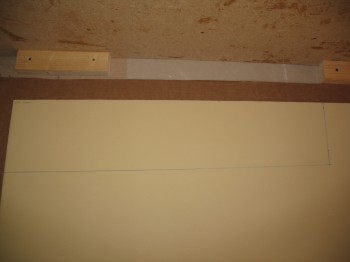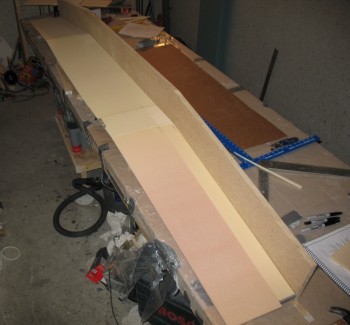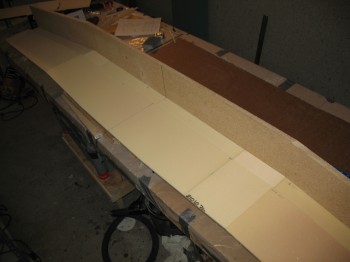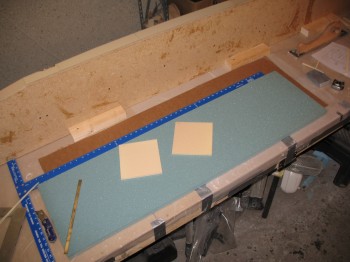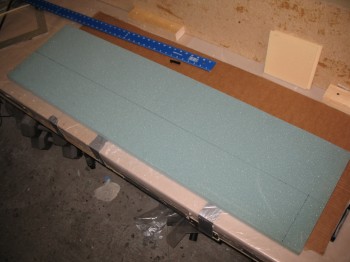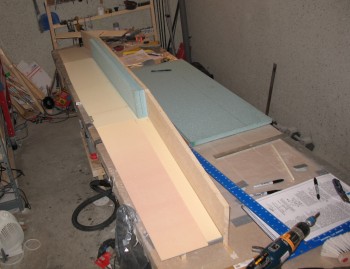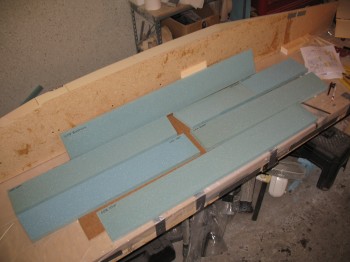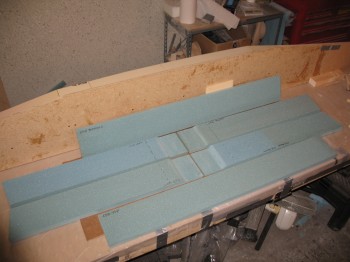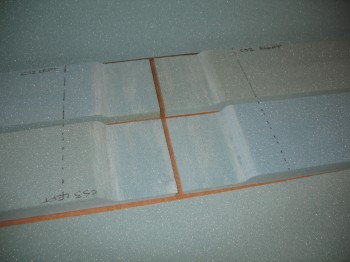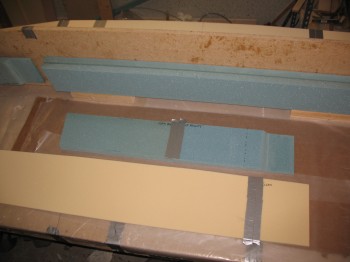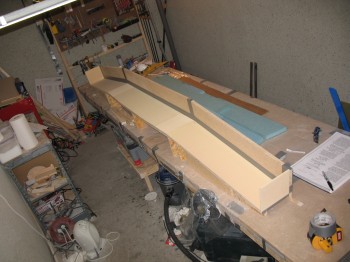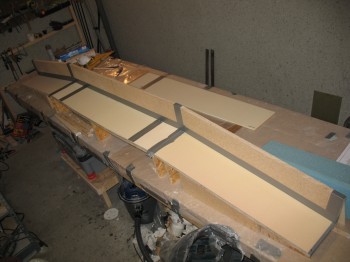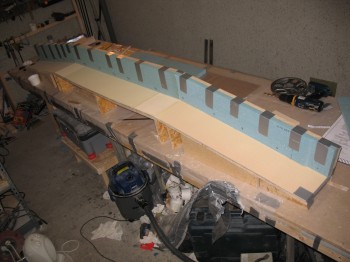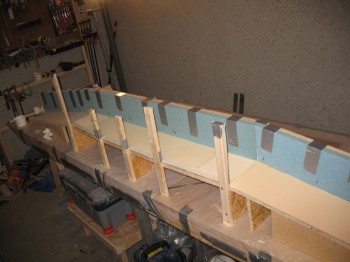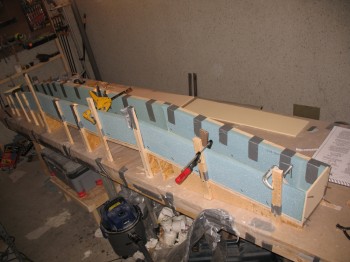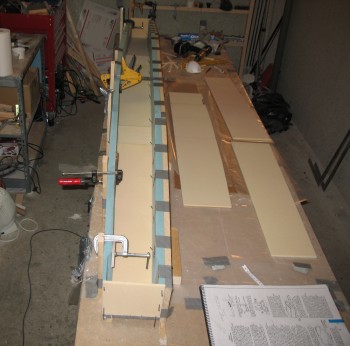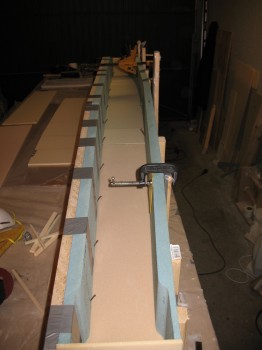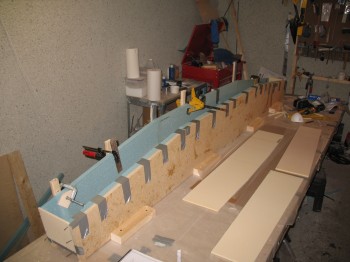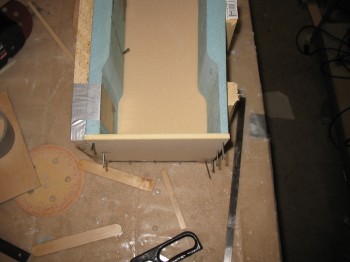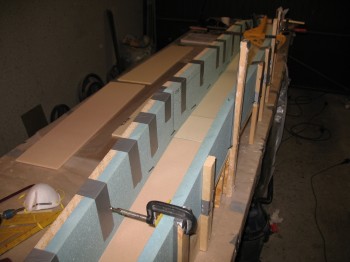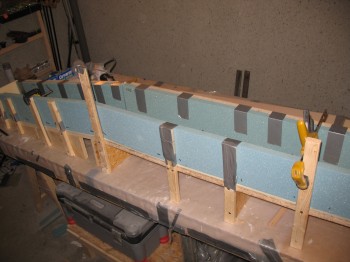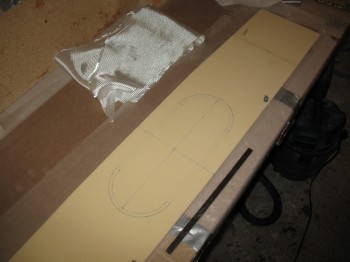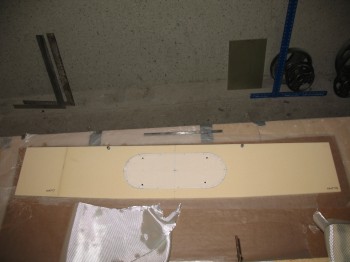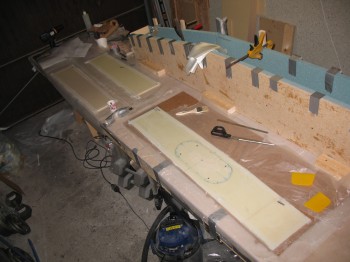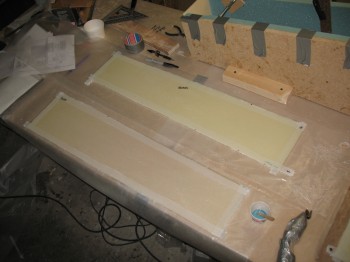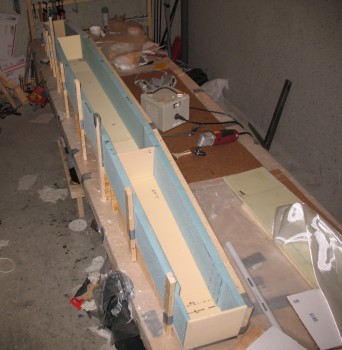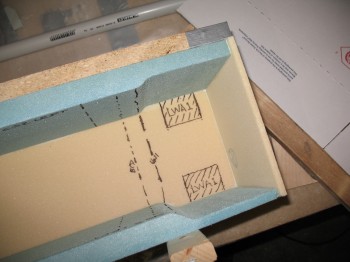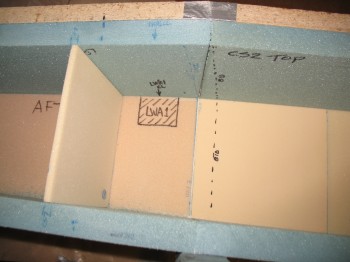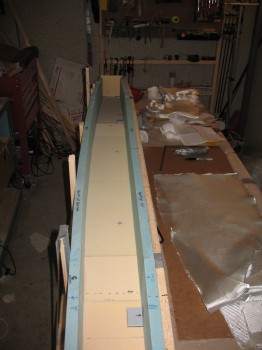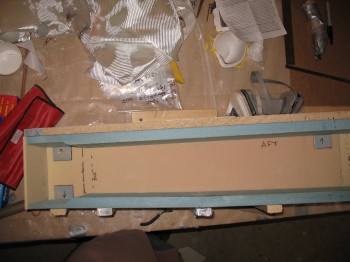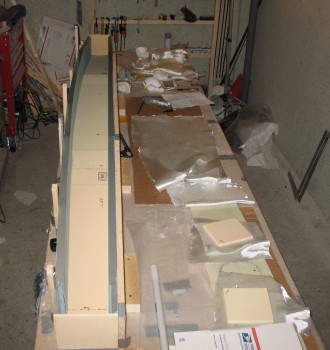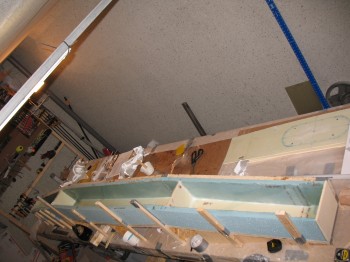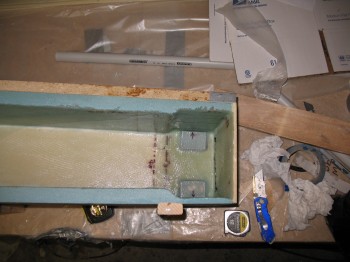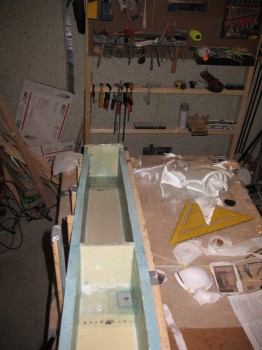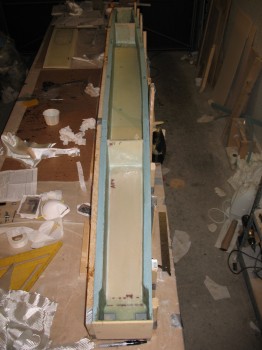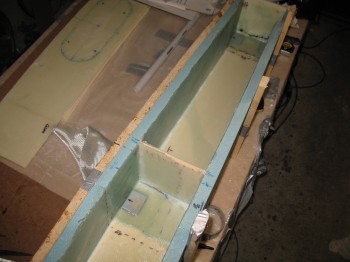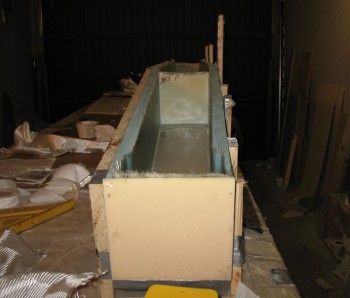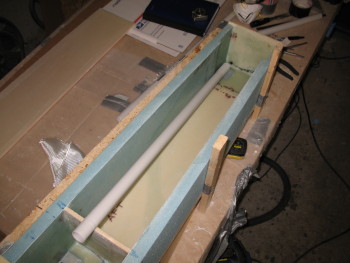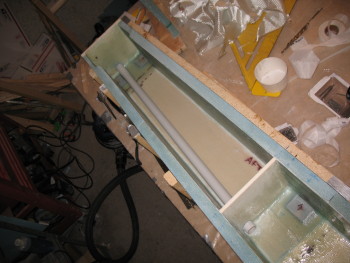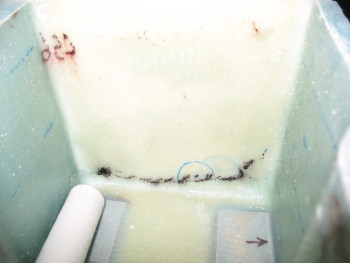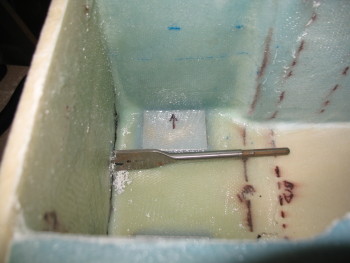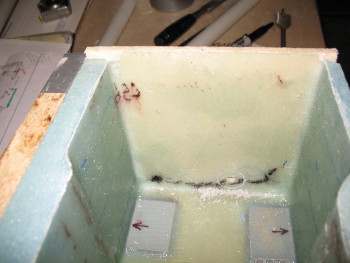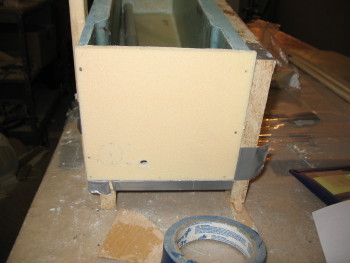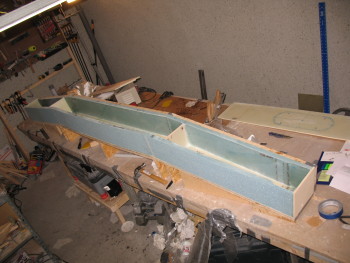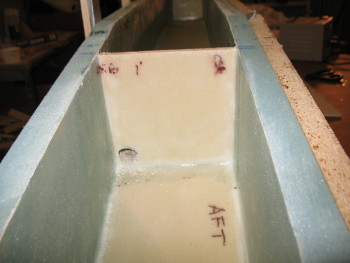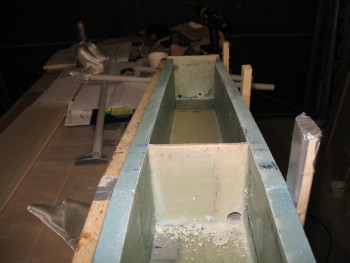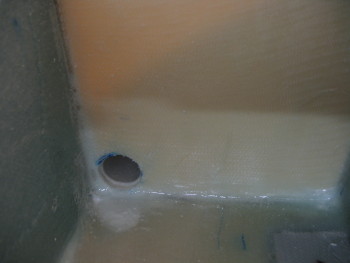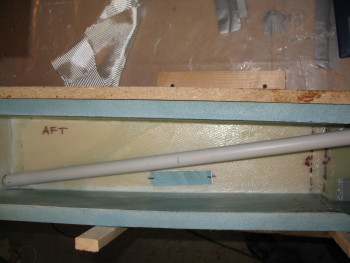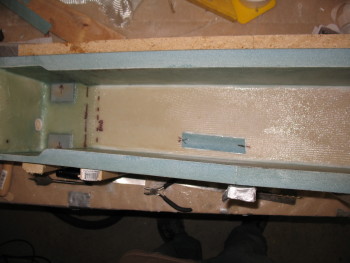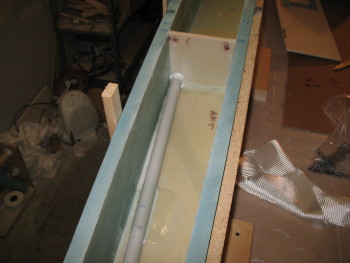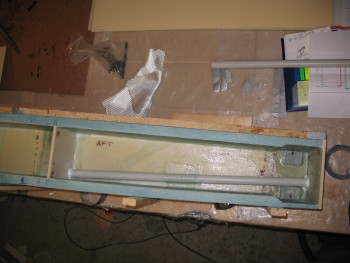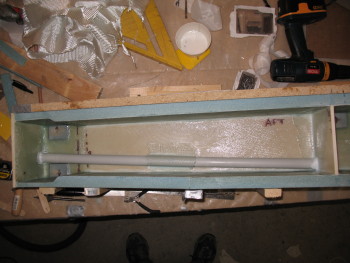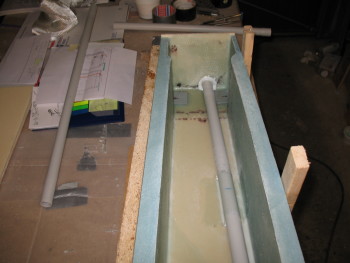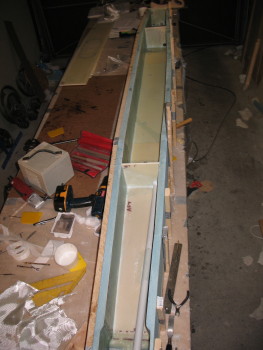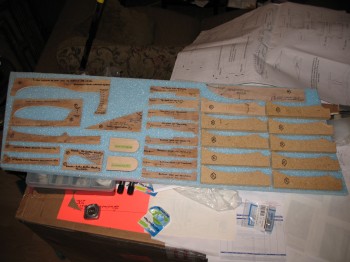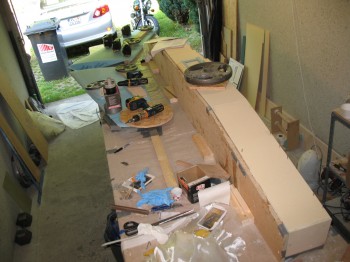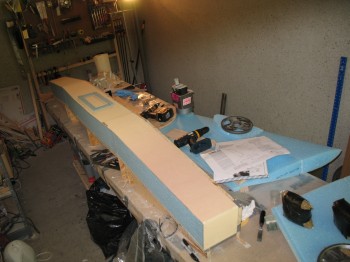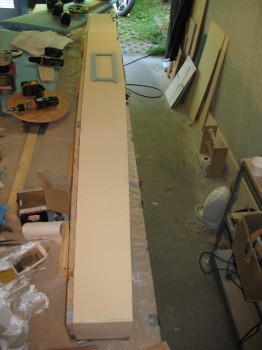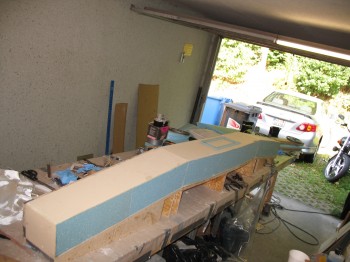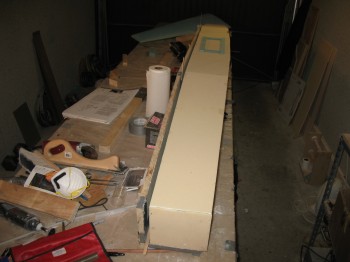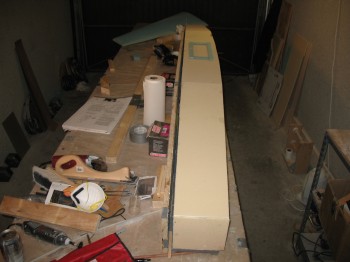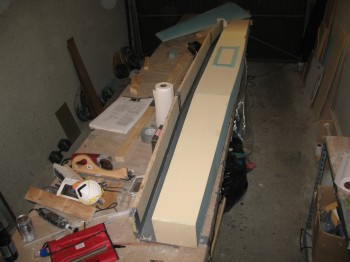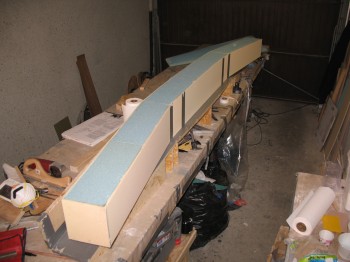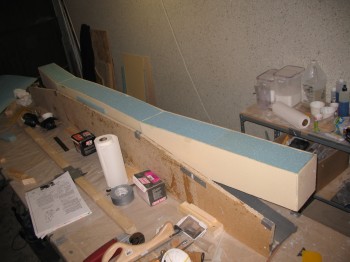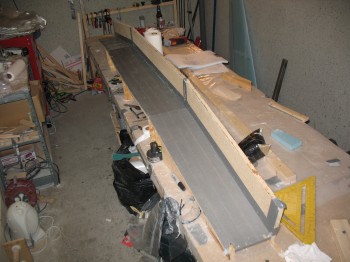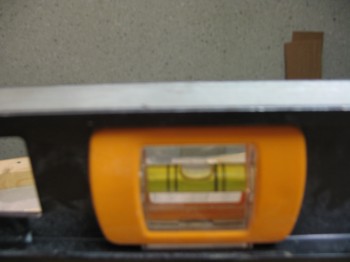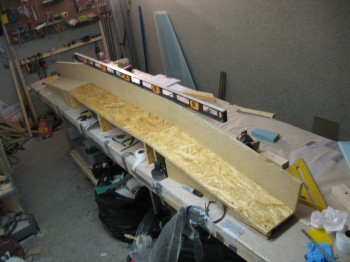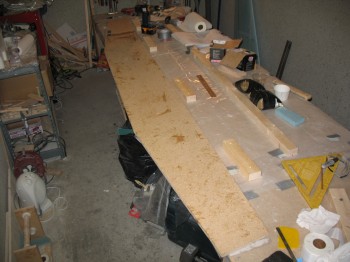Chapter 14 — Centersection Spar: Building the Spar Box
23 July 2012 — I cut the aluminum extrusions (LWAs) for the Centersection (CS) Spar (Chapter 14) & Wings (Chapter 19).
•••
24 July 2012 — Finally got some Alumiprep to go with my Alodine! If I haven’t covered Alodine earlier, it is simply a corrosion protection application to keep aluminum (yes, aluminum does corrode!) from deteriorating and losing strength over time. This is especially important for composite airplanes where these metal extrusions are embedded into the foam & glass and cannot no longer be assessed or examined for any corrosion–for the life of the plane–without actually tearing into the glass to see it.
The Alodine process is fairly simple: the Alumiprep is an acid that does a super-scrub on the part to clean (etch) it. The part is soaked in Alumiprep for a couple of minutes. Then the part is rinsed off with water and put into the Alodine for a couple of minutes where it turns a greenish-goldish-brown & receives its corrosion protective coating. It’s rinsed with water once again and allowed to dry.
Click here for a good video showing How to Acid Etch and Alodine Aluminum.
I used the Dremel & mini belt sander to make the 0.1″ & 0.2″ rounded-over edges on the aluminum extrusions.
I Alodined all the cut aluminum pieces and set them up to dry. I had a sneaking suspicion that my Alodine was a little bit on the old side. No matter what I did, pre-cleaning, leaving the piece in either solution for significantly longer, it didn’t seem to change the intensity–either light or dark–of the Alodined parts.
•••
25 July 2012 — I took the now thoroughly dried Alodined aluminum extrusion pieces out to the back patio. I wasn’t overly thrilled with the quality of my Alodining process, so I decided to add another layer of corrosion control on the aluminum parts by adding a couple of coats of primer. But, to ensure that the glass would grip to a primer base that itself was gripped firmly to the aluminum surface, all the pieces will be lightly sanded and then prepped via a wash down with Simple Green and 3M pads to remove any “loose” and/or weak primer (this is how I prepped parts when I shot paint on my chopper project… Simple Green works great and is completely clean chemically).
After the parts dried for a few hours, I primed the other side of the aluminum parts.
•••
24 August 2012 — Since it’s only open a few days a week, I went to the wood shop on base to cut the shelves A, B & C for the Centersection (CS) Spar jig.
The CS spar is akin to a big beam that goes through the fuselage and sticks “straight” out each side of the fuselage at the aft end (where the rear square notches are in the fuselage). The CS spar is what the wings bolt to (the L-shaped “notch” in the wing wraps around the end and aft side of the CS spar) via the aluminum extrusions. It extends out away from the fuselage and it’s height is the same as the wing’s thickness. Essentially, it’s about a 10 ft long square box, about 6″ deep & 8″ high.
•••
25 August 2012 — I cut about half of the 1/4″ plywood that I had used for the fuselage bottom “sled” to use for jigs & templates for the next build, CS Spar, and a few other chapters as well. I used the 3M 77 spray glue to tack the tracings onto the plywood, and then took the wood to the base wood shop to cut out the jigs & templates.
I mocked up & then cut the wood for the CS spar jig back piece and the front “shelf” pieces. Once I got them cut to size, I mocked it up again to ensure the measurements were correct.
•••
26 August 2012 — I started assembling the jig for the Centersection Spar. I know many may be aghast at my co-mingling of different types of wood, but I had it on hand and it will all get trashed (again, at some point) eventually. I actually shipped the long pieces of particle board here from the States specifically for this jig.
The CS Spar gets built on this jig as if the airplane were flying straight up into the air. The backboard is actually the top. The shelf that is level in the middle & curves downward on each end is the back of the CS spar.
Since foam gets micro’d on the surface of the shelf… and we prefer NOT to leave any foam chunks of our CS spar left attached to the wood, I covered the entire shelf assembly with duct tape (maybe the differences in wood types was getting to me a little as well).
I then took inventory of the foam & ensured it was in good shape/undamaged.
You’ll notice (if you’re a builder) that I’m using the slightly denser 3# blue PVC foam (H45– NOT wing foam!) vs the 2# polyurethane. Both are fuel resistant, unlike wing foam which dissolves rapidly in fuel & other hydrocarbon-type liquids. Polyurethane is much easier to shape, but the dust is horrible and the chance of delaminations are much higher on the polyurethane. I generally use wood working tools on the foam anyway, so the blue foam should be ok to work with.
I started by cutting the 3 large front pieces (on the jig, the front is situated on top).
Once I got the front pieces cut, I cut the identical back pieces (which are on the bottom shelf of the jig as it gets built). The pics below have both the front & back pieces, they’re just staggered.
Then I began to cut the top & bottom blue foam pieces (the sides as it’s built).
I cut the center top & bottom (side) pieces & called it a night.
•••
27 August 2012 — Well, the first major build stage for both wings is complete. For now I’ll be focusing on the Centersection (CS) Spar, with a brief intermission for working on the upper winglets. This intermission will be brought to us while the 3 front spar wall pieces cure (2-3 days as per plans) after they are micro’d in place on the spar box.
I finished cutting the top & bottom sides (remember, front & back in the jig) of the blue PVC foam.
I then routered out the end channels on the blue PVC foam to leave a 0.7″ wide tab for the top & a 0.4″ wide tab on the bottom.
I then had to micro some smaller pieces together (blue foam) to make up the full length pieces that would be assembled & make up the top & bottom walls (front & back on jig) of the spar.
I then micro’d 3 pieces (yellow foam) together to make up the back wall (lying on the flat center shelf) & then micro’d the Left & Right outer pieces (that lie flat but slope down) that make up the entire back wall of the spar. Again, these foam pieces cover the entire duct taped shelf.
I then micro’d the the 3 blue PVC top spar pieces (back jig wall) both to each other & down onto the back wall (yellow foam lying flat on the shelf). I held the blue foam into place with nails driven at an angle into the yellow foam & strapped it to the back wall with duct tape.
Most builders will recognize the scrap wood I used for the jig’s front wall support tabs as the same scrap that is used to protect foam shipments from Aircraft Spruce. I screwed (not bondo’d!) these wood support tabs to the front of the jig to micro the bottom center spar piece in place (bottom spar = front jig). I then added more front wood jig supports to micro the Left & Right side bottom spar blue foam pieces into place so that a 3-sided channel consisting of the top, back and bottom spar walls was created. I used finish nails, duct tape & clamps to hold the bottom PVC foam spar wall in place.
I then micro’d on the CS spar’s yellow foam end caps–actually classified as bulkheads–with nails as well.
I double checked all the bonds, ensured the surfaces were all mated well together & removed all the excess micro.
With the initial stages of the spar box assembled & curing, I called it a night.
•••
28 August 2012 — Tonight was a significant, but light, night build wise.
I climbed under the fuselage & took measurements for the rear CS spar mount & firewall area. One specific measurement I was looking for was the difference in the placement of my 4 Spruce hard points/inserts, since my fuselage is slightly wider & the side walls exit the fire wall going forward at a slightly steeper angle than stock. These 4 Spruce hard points will get embedded into the foam & become part of the CS spar’s upper & lower wall. Then both fuselage & engine mount arms will be bolted to the CS spar via these wood hard points.
I cut the BID glass for the INSIDE of the 3 pieces that make up the front CS spar wall.
I cut the UNI & BID for Step #4, which is where the aluminum extrusions for the CS spar get installed.
I took the rest of the night off.
•••
29 August 2012 — A significant mod that I’m making concerning the CS Spar is that I’m running the rudder cable conduits through the interior sidewalls of the fuselage & then through the front & back wall of the CS spar. Note, this is not an afterthought action, so I won’t just be merely drilling holes through the inside & outside glass surfaces of each spar face. What I will be doing, after much consultation with the old guard, is carefully separating the glass fibers so they stay intact and are simply rerouted about 0.04″ to 0.13″ to each side of the hole to make room for a small 3/16″ hole on the exterior spar walls, and a 1/4″ hole on the interior walls. Inside the spar I will run a phenolic conduit for the Nylaflow rudder cable conduit to run through. Thus, to cite an overused reference, there will be no glass harmed in the making of this CS spar.
That being said, I forgot about the 0.5″ wedge that gets cut off the top front & bottom edge of the spar, so I set up the 2 holes for the rudder cable conduit 0.3″ from the edge, but I set them up incorrectly on the original “un-wedged” edge of the front spar face. No worries since this all gets removed when I sand down & remove the 0.5″ angle off the front corner edges. Of course I realized this after I had laid up the BID glass!
One other slight change I made was more out of curiosity than any build mod. I tacked a piece of peel ply under the BID on the very front spar piece where the 5″ x 14″ oval access hole will be cut out. The plans don’t have you peel ply this, but I went 5/16″ beyond the edge of the hole since after the hole foam/glass gets removed, 0.25″ of the foam gets removed & the glass on the edge of the hole prepped so the outer front face glass will have a good glass-to-glass bond when that layup is complete (i.e. inside spar glass bonded to outside spar glass).
I prepped the foam for the spar’s front center face (interior side) with microslurry, then glassed the 1-ply BID layup. I then peel plied 1″ along the edges, since the edges will be micro’d to the blue foam edges at the front (currently top as jig is configured) of the spar box.
I then did the same thing with both the Left side & Right side spar front face pieces: microslurried then glassed a 1-ply BID layup with 1″ peel ply around the edges.
Again, these layups were all on the interior side of the pieces that will make up the front of the spar. The exterior front of the spar is pretty much the last thing that gets glassed on the spar (actually the 2 square end bulkheads are the last to get glassed, but who really counts those…?!)
After the front face pieces were glassed, I marked the foam inside the spar box with a Sharpie near the interior 2 bulkheads where the respective BID & UNI layups will be glassed.
I also marked the positions where the rudder cable conduit will exit on the aft CS spar wall (10.2″ L & R of CL & 1.8″ below the inside top wall of spar).
•••
30 August 2012 — I marked up where the Outboard aluminum extrusions (LWA1) will go (on the inside of the spar box).
I then marked up where the Inboard aluminum extrusions (LWA1) will go (on the inside of the spar box).
Below is a shot of all the aluminum extrusions on the Right-hand side of the CS spar. The extrusions will sit at the back of spar box & align with the aluminum extrusions on the Right wing. A 5/8″ hole will get drilled through all the extrusions at each of the 3 hard points, and 3 large 5/8″ wing bolts will hold each wing on.
I pulled the 1″ peel ply off the CS spar front face pieces (yellow foam/CS4) & then cut the edges smooth with the “Fein” saw.
Another mod I found somewhere, I don’t remember right now (It may have been a Marc Zeitlin or Vance Atkinson noted mod from the Cozy world … but don’t quote me), is installing a permanent plastic conduit between the outer end bulkhead and the interior bulkhead on each side, about 1″ round in diameter, as an electrical wire/antenna cable conduit. So I cut & played around with some nice, thin lightweight conduit I picked up at the Aviation Dept at Praktiker (German Lowe’s). You can see a bit of the grey thin-walled conduit–much thinner than PVC pipe–in the pic below at the bottom.
I made 4 each ~4-pound sandbags to use during the remaining build projects.
I cut BID for the spar box & individual pieces for all 4 bulkheads. I then sanded down the joints between middle blue foam pieces & the outer foam pieces to align them.
I vacuumed the inside of the spar & then taped off the front of the blue PVC foam.
I spread dry micro as a fillet in the corners & microslurry on the large foam “fields.”
I then glassed Layup #2, which is the whole interior of the spar box (technically 3 individual compartments with the 2 interior bulkheads) with 1-ply of BID.
At the inboard attach hard points on each side I glassed Layup #3 which is a staggered 3-plies of UNI over the embedded LWA5 extrusion and under the interior aluminum extrusion (LWA1). After each LWA1 is in place, they then get covered with 1-ply of BID.
I then glassed Layup #4 which is essentially the same as Layup #3 but at the outboard attach hard points on each end of the spar. Since the aluminum extrusions are opposite sides of the back foam wall (top & bottom when on the plane, front & back as it lies on the jig) the 3-plies of UNI are laid into the spar box starting from one wall of the spar (as it sits) along the bottom as a base pad for each LWA1 and then up the other spar box wall (creating this shape layup: ⌊⌋ ). Then both LWA1 extrusions are set in place with 1-ply BID to hold them in place.
•••
31 August 2012 — Today I measured out and looked at different wiring & conduit options. I decided to go with Marc Zeitlin’s method (I guess I should have checked my notes before yesterday’s post!).
I have to apologize ahead of time because I swore I took pictures of today’s progress, but currently I can’t find them. I will keep looking though. [Ed. Note: Sep 2015 – A LEZ building buddy of mine was looking at this part of my blog while prepping to build his CS Spar when he noted that the pictures for this section weren’t here… well, lo & behold he went back through his emails, found them, and then sent them to me to post! So the following pics are courtesy of a fellow canardian who is taking care of the familia! Hoo-ah! –Airdog]. So, on with the build log:
I cut a 1″ hole half-way through the foam of the end bulkheads from the inside of the spar box. I’ll cut a 7/8″ hole later on from the outside, going into & more closely matching the Inside Diameter of the 1″ tube on the inside of the bulkhead.
Here are some shots of the exterior end of the outboard bulkhead.
As I said before, the 1″ tube will simply run from the outside bulkhead to the interior bulkhead to serve as a conduit to get all the wing electrical wires and antenna cables cleanly from the wing, into the CS spar to be routed from there throughout the fuselage.
This will be on both sides of the CS spar, so one conduit on each side. The hole I cut (drilled) on each end bulkhead is just above the bottom aluminum extrusion to keep as close to the bottom of spar & shear web as possible, but still allow clearance for the wing bolt.
I then drilled holes in the aft bottom corner of both interior bulkheads, opposite the exterior bulkheads. I cut the ~1″ (technically 25mm) plastic tubing at a slight angle on each end to fit cleanly on both sides & into the recessed holes on the interior side of the Outboard bulkhead and the vice versa on the Inboard bulkhead.
I used a 3/16″ x 5″ scrap piece of blue foam to prop up the middle of the plastic tube–since it was suspended between each bulkhead–to cut on down on any possible vibration tendencies, rattling, etc. I used micro to attach the blue foam block to the interior back wall of the spar.
I then micro’d both ends of the plastic tube in place into each of the recessed holes on the bulkheads (one tube on each side of CS spar). I also micro’d the center of the tube to the blue foam block. I then glassed a 1-ply BID 4″ x 8″ layup over the pipe & blue foam block.
Ok… Although I am both a convert & believer of Burt, I guess sometimes I doubt a little if something is as strong as it is… even though it would probably far exceed my expectations. Thus was the case with attaching the front foam pieces to the rest of the spar box (remember, this is the “top” as it sits in the jig). I measured out where the interior bulkheads would abut the interior front spar face, marked it and sanded it down for a future 1-ply BID corner tape just for a little reinforcement (mod… not per plans). Not that I was doubting Burt in his design, I was merely “helping” him out . . . haha!
I then (per plans) prepped the front spar pieces for attachment to the rest of the spar box. I removed more peel ply boogers & sanded down some areas need extra attention.
I removed the front wood jig supports, thoroughly vacuumed the inside of the spar box, and wiped down the front (soon-to-be-mounted) spar wall pieces.
I taped the edges of any foam that would subject to any type of micro slop & mess. I then micro’d, nailed and weighed down the front (yellow foam) spar wall pieces (top as far as the jig is set) to the rest of the spar box.
Clock start time for my “2-3 day cure time” was 0100 Saturday morning.
I checked the micro’d pieces ~2 hours later & put some more nails to hold some areas better into place & aligned. I also removed a bunch of tape & gummy micro.
•••
1 September 2012 — As the CS spar cured, I started by spending around 2 hours at the Ramstein base wood hobby shop. I finished cutting a bunch of templates, jigs & parts–mainly for the canard build, but in the pic below in the whole center row are the jigs for the CS spar’s spar caps: 4 for the top, and 4 for the bottom.
I also bought stuff to restock the basic composite working supplies: duct tape, tacks, etc.
•••
•••
3 September 2012 — I removed the CS spar from its jig after it had cured for about 3 days, and then tore down the jig (Plus, getting the CS spar off the workbench made glassing the final winglet layups a whole lot easier).
The pic below shows that the whole jig stayed fairly level during the course of the first major part of the CS spar build.
•••
4 September 2012 — I ginned up some 50/50 flox/micro mix to fill in some minor gaps between the foam joints on the CS spar.
•••

